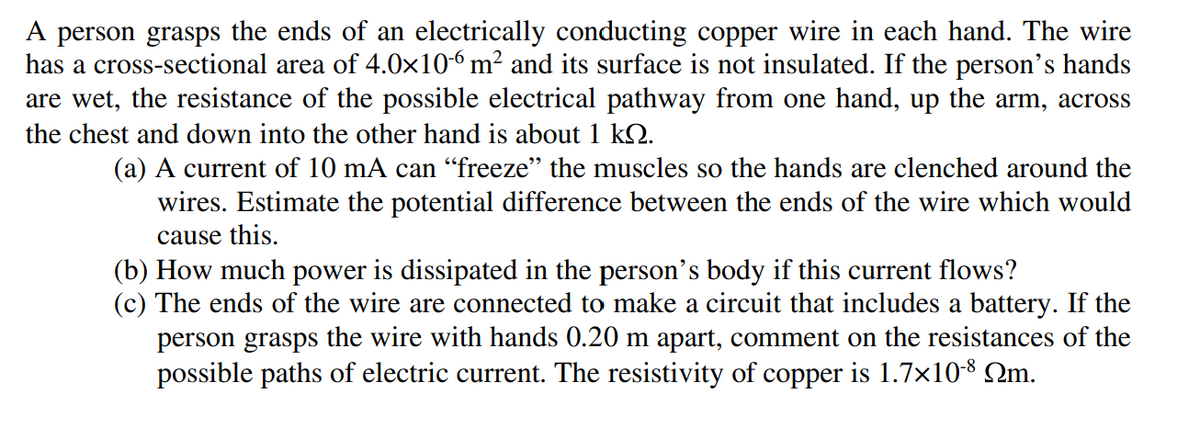A person grasps the ends of an electrically conducting copper wire in each hand. The wire has a cross-sectional area of 4.0×10-6 m² and its surface is not insulated. If the person's hands are wet, the resistance of the possible electrical pathway from one hand, up the arm, across the chest and down into the other hand is about 1 kQ. (a) A current of 10 mA can "freeze" the muscles so the hands are clenched around the wires. Estimate the potential difference between the ends of the wire which would cause this. (b) How much power is dissipated in the person's body if this current flows? (c) The ends of the wire are connected to make a circuit that includes a battery. If the person grasps the wire with hands 0.20 m apart, comment on the resistances of the possible paths of electric current. The resistivity of copper is 1.7x10-8 Qm.
A person grasps the ends of an electrically conducting copper wire in each hand. The wire has a cross-sectional area of 4.0×10-6 m² and its surface is not insulated. If the person's hands are wet, the resistance of the possible electrical pathway from one hand, up the arm, across the chest and down into the other hand is about 1 kQ. (a) A current of 10 mA can "freeze" the muscles so the hands are clenched around the wires. Estimate the potential difference between the ends of the wire which would cause this. (b) How much power is dissipated in the person's body if this current flows? (c) The ends of the wire are connected to make a circuit that includes a battery. If the person grasps the wire with hands 0.20 m apart, comment on the resistances of the possible paths of electric current. The resistivity of copper is 1.7x10-8 Qm.
College Physics
10th Edition
ISBN:9781285737027
Author:Raymond A. Serway, Chris Vuille
Publisher:Raymond A. Serway, Chris Vuille
Chapter18: Direct-Current Circuits
Section: Chapter Questions
Problem 18P: (a) Find the current in each resistor of Figure P18.18 by using the rules for resistors in series...
Related questions
Concept explainers
Ohm's law
Ohm’s law is a prominent concept in physics and electronics. It gives the relation between the current and the voltage. It is used to analyze and construct electrical circuits. Ohm's law states that the voltage across a conductor is directly proportional to the current flowing through it.
Path of Least Resistance
In a series of alternate pathways, the direction of least resistance is the actual or metaphorical route that offers the least resistance to forwarding motion by a given individual or body.
Question

Transcribed Image Text:A person grasps the ends of an electrically conducting copper wire in each hand. The wire
has a cross-sectional area of 4.0×106 m² and its surface is not insulated. If the person's hands
are wet, the resistance of the possible electrical pathway from one hand, up the arm, across
the chest and down into the other hand is about 1 kQ.
(a) A current of 10 mA can “freeze" the muscles so the hands are clenched around the
wires. Estimate the potential difference between the ends of the wire which would
cause this.
(b) How much power is dissipated in the person's body if this current flows?
(c) The ends of the wire are connected to make a circuit that includes a battery. If the
person grasps the wire with hands 0.20 m apart, comment on the resistances of the
possible paths of electric current. The resistivity of copper is 1.7x108 Qm.
Expert Solution
Step 1

Step by step
Solved in 3 steps with 3 images

Knowledge Booster
Learn more about
Need a deep-dive on the concept behind this application? Look no further. Learn more about this topic, physics and related others by exploring similar questions and additional content below.Recommended textbooks for you

College Physics
Physics
ISBN:
9781285737027
Author:
Raymond A. Serway, Chris Vuille
Publisher:
Cengage Learning

College Physics
Physics
ISBN:
9781305952300
Author:
Raymond A. Serway, Chris Vuille
Publisher:
Cengage Learning

Principles of Physics: A Calculus-Based Text
Physics
ISBN:
9781133104261
Author:
Raymond A. Serway, John W. Jewett
Publisher:
Cengage Learning

College Physics
Physics
ISBN:
9781285737027
Author:
Raymond A. Serway, Chris Vuille
Publisher:
Cengage Learning

College Physics
Physics
ISBN:
9781305952300
Author:
Raymond A. Serway, Chris Vuille
Publisher:
Cengage Learning

Principles of Physics: A Calculus-Based Text
Physics
ISBN:
9781133104261
Author:
Raymond A. Serway, John W. Jewett
Publisher:
Cengage Learning

Glencoe Physics: Principles and Problems, Student…
Physics
ISBN:
9780078807213
Author:
Paul W. Zitzewitz
Publisher:
Glencoe/McGraw-Hill

Physics for Scientists and Engineers: Foundations…
Physics
ISBN:
9781133939146
Author:
Katz, Debora M.
Publisher:
Cengage Learning

College Physics
Physics
ISBN:
9781938168000
Author:
Paul Peter Urone, Roger Hinrichs
Publisher:
OpenStax College